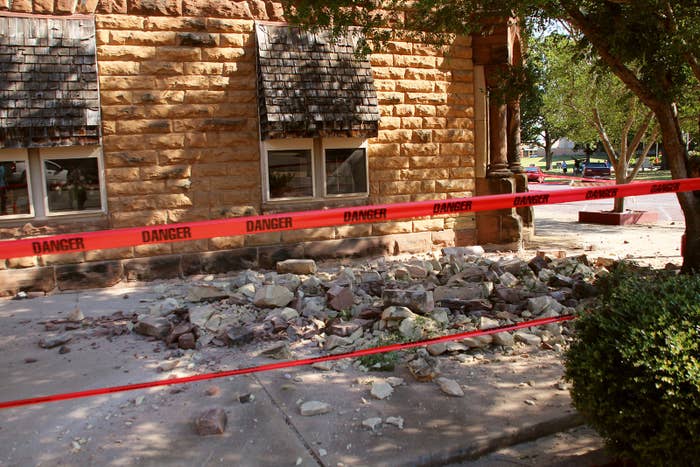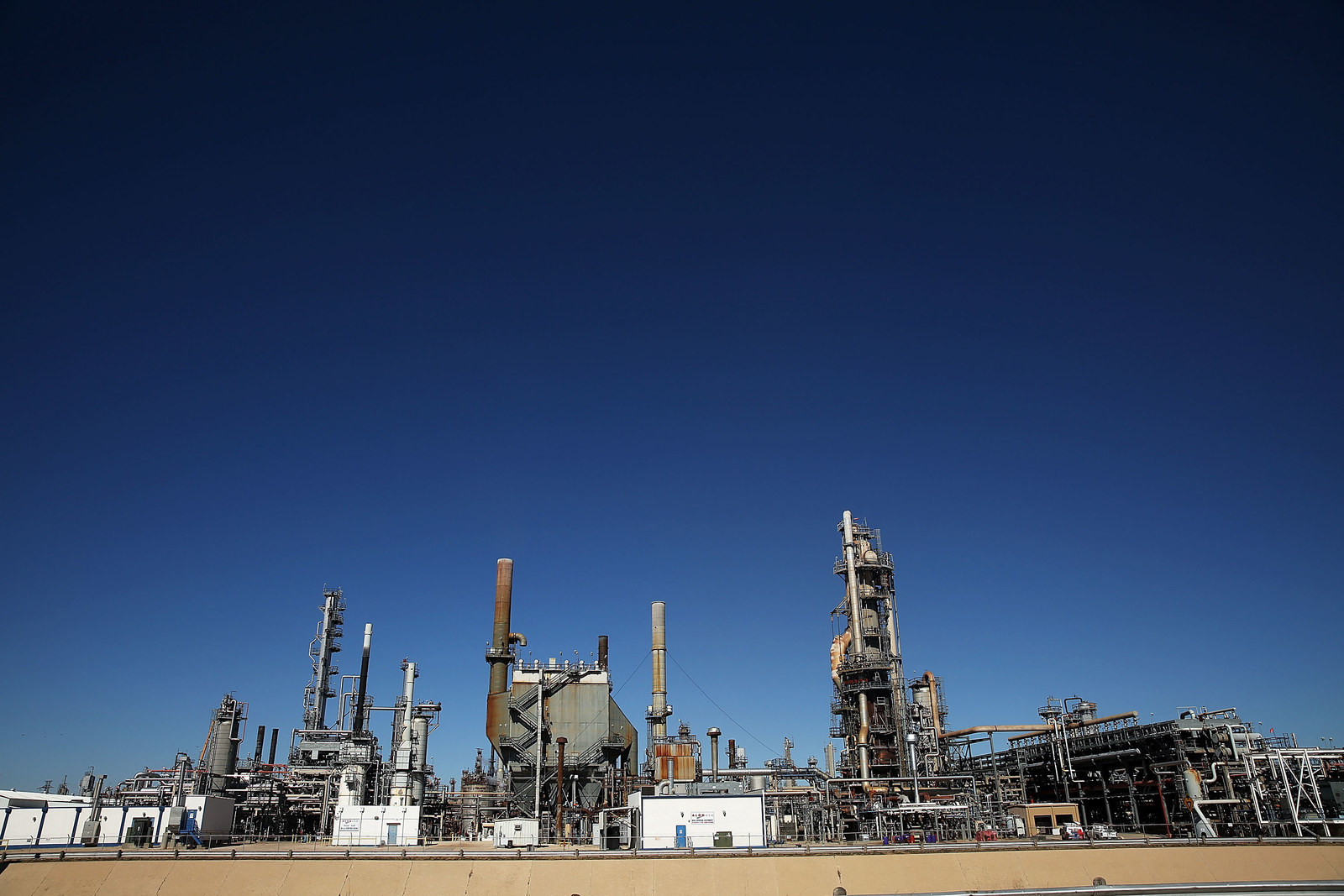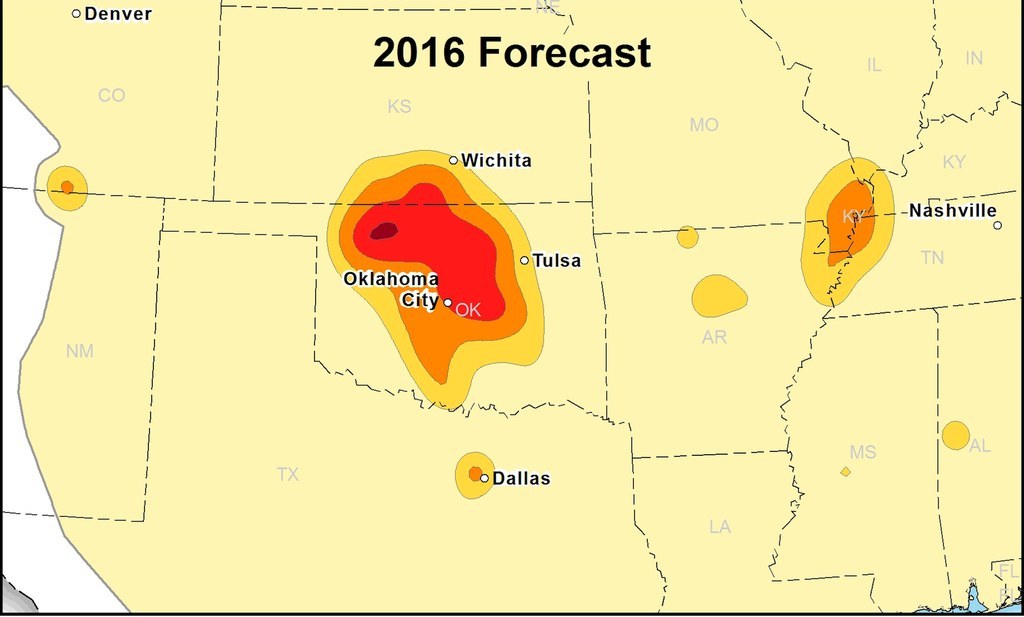
Man-made quakes will shake foundations and crack plaster across swaths of central US that some 3.5 million Americans call home, the US Geological Survey forecasts in a new report.
But regulations urging drilling cutbacks have decreased the earthquake risk in some parts of oil country, the Wednesday report adds.
“These maps are showing where you will see potential damage within one year,” Mark Petersen chief of the USGS National Seismic Hazard Mapping Project, told BuzzFeed News.
Earthquake forecasts from the USGS typically span decades and account for natural disasters, but for the first time last year the science agency published a year-long forecast to account for man-made, “induced” earthquakes. Such earthquakes have increased nearly tenfold in the last two decades in the central US, amid a boom in oil and gas drilling nationwide.
A major cause of these quakes is the disposal of briny wastewater from oil and gas extraction, which is returned to the ground in artificial “injection” wells. In rare cases, the National Research Council warned in 2012, this pressurized wastewater can trip a geologic fault deep in the ground and trigger a quake.
“The USGS has been printing hazard maps for a long time — what’s new about these papers is the man-made hazard,” Cliff Frohlich, associate director at the University of Texas Institute for Geophysics, who was not involved with the report, told BuzzFeed News.
Map shows quakes since 2000 with a magnitude of 4 and greater, plus the percentage chance of experiencing a damaging quake in 2017.
Oklahoma, a hotspot for man-made quakes in the 2016 report, saw historically strong earthquakes last year. One struck the city of Pawnee one weekend morning in September, woke the city with sustained shaking, and caused minor damage to buildings and bridges. It was the most powerful ever recorded in the state. But the overall number of noteworthy earthquakes in the state dropped from 4,000 in 2015 to 2,500 in 2016.
The Dallas Fort Worth area in Texas, home to a cluster of drilling sites, was flagged as another region of risk in the 2016 assessment. But that area saw almost no significant seismic activity. The hazard level for that area has been downgraded in the forecast for 2017.
“There’s been a dramatic decline in the number — we attribute that to probably a reduction in injection rates,” Petersen said. “This is good news. This is a success story.”
He said this is evidence that decreasing injection activities through regulation or other means can lead to a corresponding drop in quake risk.

For example, the Oklahoma Corporation Commission, the state’s oil and gas regulator, seeks to cap volumes of wastewater injected at earthquake-risk sites to 40 percent of the level in 2014. Oil companies also decreased the volume of wastewater disposed at locations in Texas, Petersen said.
“From what we have seen, induced seismicity can be curtailed,” Jefferson Chang, a geophysicist at the University of Oklahoma, told BuzzFeed News. Lower oil prices in the last 12 months, leading to less oil extraction, are another factor, he said.
But the report indicates that Oklahoma is not out of the woods yet: “I think we have to remain vigilant,” Chang said.
John Armbruster, a professor of geology at Columbia University, told BuzzFeed News that the report was a “careful, thorough job.” But these warnings presented communities with a conundrum, he said: “How should people respond to this? Should people rebuild houses if things go the other way in a few years?”
In crafting their model, the USGS scientists included information about earthquakes that had previously occurred in the region. But they did not include the locations of drilling sites or injection sites.
Frohlich said this is a limitation of the forecasting method.
“I’ve always thought that their method works better in a situation like Oklahoma, versus a situation like Texas,” he said — that’s because there is a much higher volume of injection taking place at sites in Oklahoma compared to its neighbor to the west.
Though imperfect, Frohlich said this approach is necessary to break ground towards better forecasting induced quakes. “Man-made earthquakes have become important and someone has to start somewhere,” he said.
UPDATE
This story has been updated to include comments from John Armbruster.


